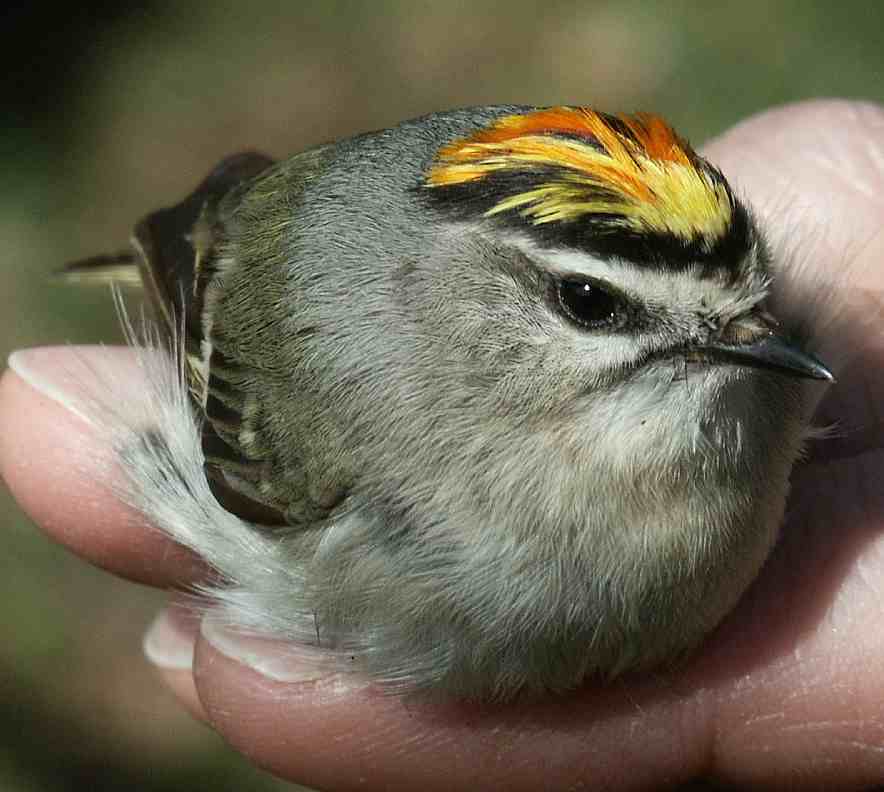'crests (and Kinglets) (15 December 2003)
Today (15 December 2003) I was pleased to ring a Firecrest Regulus ignicapilla, along with several Goldcrests Regulus regulus. These species share the title of Britain's smallest bird, yet they manage to over-winter successfully here. Indeed, many of the 'crests here in the winter have come from colder areas farther east, especially Scandinavia. At an average winter weight of only a little over 5 grams (one-sixth of an ounce) it is amazing that they can survive. They are exclusively insectivorous throughout the year and they must find sufficient small invertebrates, spiders and the like, tucked away in the nooks and crannies of the coniferous trees that they favour.
.jpg)
.jpg)
The orange colours in the crown show that both of these birds are males, but they usually keep their fiery golden crown feathers hidden except when displaying:
.jpg)
This photograph also shows the delicate bronze-coloured shoulder patches that are characteristic of the species. In the last 20 years or so, Firecrests have become considerably more common in Cheshire and Wirral. Tony Ormond and I are currently analysing the data and intend to publish a paper soon.
They are difficult to age, as their usual moult limits are almost impossible to discern. The only ageing criterion given by Svensson for Goldcrest and Firecrest, after skull ossification is complete, is the shape of the tail feathers: broad and rounded for adults or narrow and pointed for first-years. Svensson depicts extremes of rectrix shape and gives the warning 'do not age intermediates between these two', while Jenni & Winkler state that the use of tail feather shape 'assigns many individuals to the wrong age class'. In my experience, few birds are found with broad and rounded rectrices, even retrapped ringed birds that are known to be at least two years old, and there are examples of known adults with 'pointed' rectrices, including a Firecrest retrapped two years after ringing (Jackson, Ringing & Migration 13, 127 (1992)). Today's Firecrest had very pointed tail feathers:
.jpg)
These two species have their North American counterparts, and I have now ringed (or banded!) all four of them this autumn, with Ruby-crowned Kinglet Regulus calendula and Golden-crowned Kinglet Regulus satrapa at Powdermill Nature Reserve in September/ October. These photographs show males:
.jpg)

Female Ruby-crowned Kinglets have no red on the head, although occasional adult birds might have one or two red feathers. Typical female birds look very plain:
.jpg)
The North American Regulus species are just as difficult to age as the European ones. The Identification Guide to North American Birds (Peter Pyle, Slate Creek Press 1997) gives identical wording for both:
Hatch Year - 'molt limits sometimes occur (but are very indistinct) among the median and greater coverts, the retained outer coverts worn and brownish with indistinct dingy-whitish tips, contrasting with the fresher, duskier and distinctly white-tipped, replaced inner coverts; outer primary coverts narrow, tapered, relatively abraded, and brownish with indistinct, relatively narrow, or no dingy-olive edging'.
After Hatch Year - 'wing coverts uniformly adult, dusky with fresh green edging and distinct, white tips; outer primary coverts broad, truncate, relatively fresh, and dusky with distinct, relatively wide, greenish-olive edging'.
Pyle also adds the cautionary note: 'many intermediates can occur'.
Both Golden-crowned Kinglet and Firecrest, when seen head-on, can have quite a piratical look to them. The taxonomists say that they are different species, but their similarity is depicted in the last photo, below, which shows a GCKI (left) and FIREC(right).
.jpg)
David Norman.